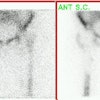Radiographics 2002 Jan-Feb;22(1):5-17
Detection of Locoregional and Distant Recurrences in Breast Cancer Patients
by Using FDG PET.
Eubank WB, Mankoff DA, Vesselle HJ, Eary JF, Schubert EK, Dunnwald LK, Lindsley
SK, Gralow JR, Austin-Seymour MM, Ellis GK, Livingston RB.
Cases of recurrence of breast cancer can pose considerable diagnostic and
therapeutic challenges for the oncologic team. The prognosis and management
decisions are based on knowledge of the true extent of disease. Conventional
staging methods, including physical examination, assessment of levels of tumor
markers, cross-sectional imaging, and bone scintigraphy, may not reliably
demonstrate the extent of disease in all cases. Physical examination and
cross-sectional imaging (computed tomography [CT] or magnetic resonance imaging)
can be problematic because (a) the sequelae of previous surgery and radiation
therapy can be difficult to distinguish from recurrent neoplasms and (b) early
metastatic disease (small lesions) can be difficult to distinguish from benign
lesions that are too small to characterize. Positron emission tomography (PET)
with 2-[fluorine-18]fluoro-2-deoxy-D-glucose (FDG) can help clarify inconclusive
findings from physical examination and cross-sectional imaging. FDG PET is more
sensitive than CT in detection of lymphatic spread of disease to locoregional
and mediastinal nodes. Metastases at distant sites including the lung, bone, and
the liver are also readily detected at FDG PET. FDG PET has been proved accurate
in restaging cases of recurrent breast cancer and will likely aid in directing
therapy in these cases. Copyright RSNA, 2002







